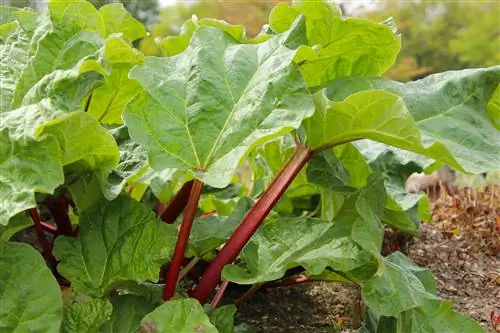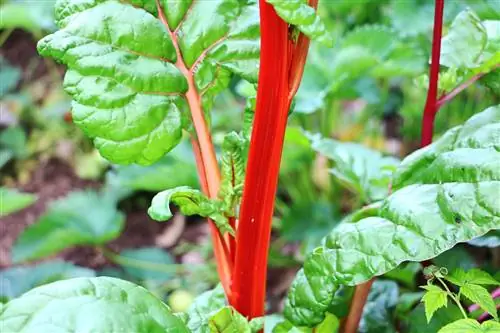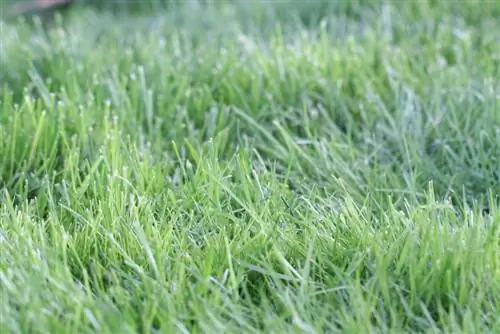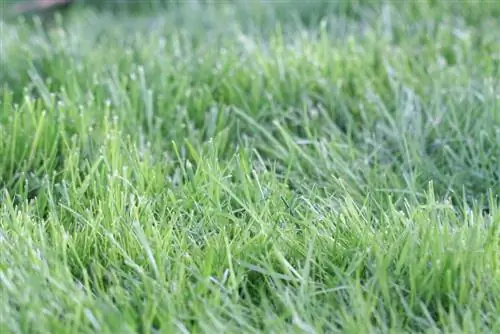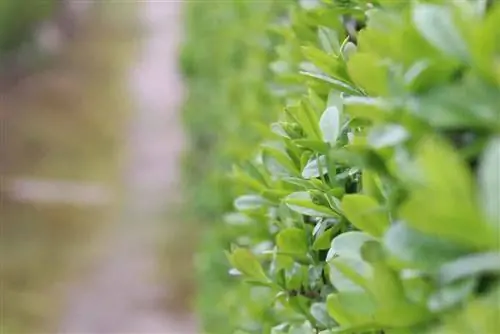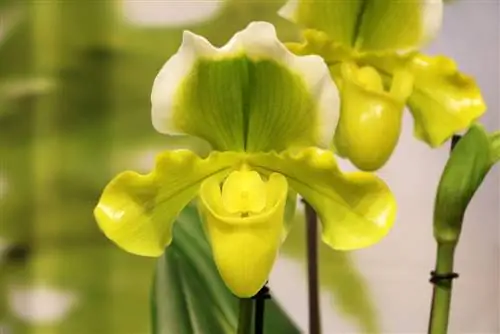- Author admin [email protected].
- Public 2023-12-17 03:39.
- Last modified 2025-01-24 12:45.
When prepared correctly, rhubarb is a real treat. However, in order to thrive, it needs sufficient nutrients. The right fertilizer plays an important role.
Organic or mineral?
Rhubarb is a heavy eater, so it needs plenty of nutrients. There is a lot to be said for organic fertilizers with a long-term effect. But why should you give them preference over mineral fertilizers?
- decompose slowly
- supply plants with nutrients in the long term
- promote humus formation, improve soil structure
- Overfertilization is hardly possible, risk of leaching is low
- mineral fertilizers, higher nutrient concentration
- Overfertilization possible quickly
- Effects immediately, but only for a short time
- no benefit for soil and soil organisms
- can affect the pH of the soil
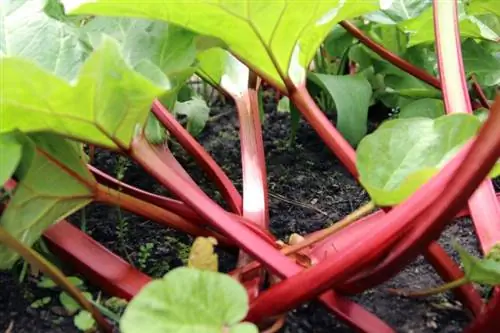
Right time
Basically, rhubarb should be fertilized two to three times a year. The first fertilization should take place when planting. From the second year onwards, fertilize for the first time before or with budding in early spring, around the end of March and the beginning of April. The second fertilizer application follows immediately after the harvest at the end of June. Rhubarb can also be fertilized in autumn about two weeks before the first frost.
Organic fertilizers
Mature compost
Compost is a valuable fertilizer that is ideal for fertilizing rhubarb. It is suitable for both spring and autumn fertilization. However, it should be well seasoned, i.e. ripe, which is the case after nine to ten months at the earliest. Then it should be used as soon as possible, because the longer it sits, the more the nutrient content decreases.
- suitable for year-round fertilization
- sieve before fertilizing
- apply generously during the growth phase
- about three liters per square meter
- approx. two to five centimeters thick layer
- work flat into the soil
- ideally with three handfuls of horn shavings
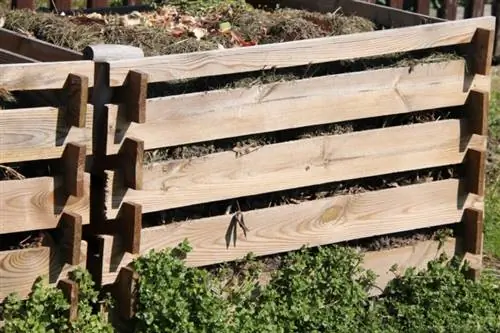
After a ripening period of six months it is referred to as “fresh compost”. It contains a lot of quickly available nutrients, but is not suitable for fertilizing as it would burn the roots. In this state of maturity it should only be used for mulching.
Tip:
A mulch layer of leaf compost or grass clippings protects against drying out and provides the rhubarb with additional nutrients.
Plant cessation
Plant manure is a highly effective fertilizer for heavy-consuming rhubarb. They contain a lot of nitrogen and potassium, which ensures vigorous growth. A manure made from nettles is particularly suitable for fertilization. But how do you make them and what should you pay attention to when fertilizing?
- from 1 kg fresh or 250 g dried herb
- Roughly chop the nettles, add 10 liters of water
- in containers made of plastic, wood or earthenware, no metal
- place in a sunny place, cover, stir daily
- ready for use when manure no longer foams
- sieve and dilute (1 part manure / 10 parts water)
- administer via the irrigation water
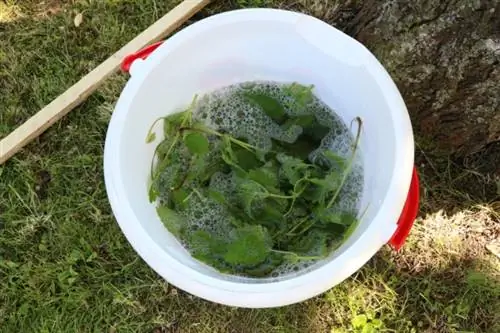
Plant manure is a good source of nitrogen after harvest. It is also suitable for follow-up fertilization in spring during the main growth phase. You pour directly onto the root area.
To reduce the strong smell of the manure during fermentation, you can add some rock dust.
Horn shavings, horn semolina or horn meal
Animal remains such as horn shavings are also a suitable fertilizer for rhubarb, preferably in combination with compost. These are almost pure nitrogen fertilizers. The proportions of sulfur, potassium and phosphorus are comparatively low. The application here is also incredibly easy.
- for fertilization in spring and autumn
- in spring it is more likely to be horn semolina or horn meal
- about two to four weeks before planting
- It's best to incorporate horn shavings in the fall
- in the planter even during the growth phase
- spread all horn fertilizers generously around plants
- work in lightly, then water well
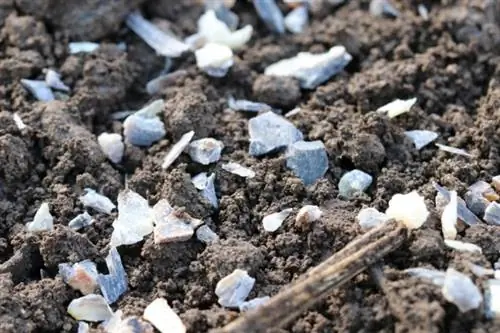
With these fertilizers, the grain size determines the efficiency. While horn shavings (grain size over five millimeters) are more likely to be viewed as long-term fertilizers, horn semolina (between one and five millimeters) and horn meal (less than one millimeter) work faster, but only for a short time and are used up more quickly.
Tip:
Mixing horn shavings with compost makes sense because compost accelerates the release of nitrogen and provides additional nutrients and trace elements.
Horse manure
Another effective fertilizer for rhubarb is horse manure. It is also rich in nutrients and should be well seasoned for at least a year to avoid over-fertilization. The first dose of manure can be given in January or March, as horse manure can also protect the plants from frost. Further fertilizer application is usually not necessary for manure because its effect lasts for a relatively long time.
Mineral fertilizers
Many hobby gardeners also use mineral fertilizers such as blue grain. It provides a lot of nutrients in the short term, but is not sufficient for rhubarb in the long term. There is also a risk of over-fertilization and dissolved s alts leaching into the groundwater. If you want to use this fertilizer, you should apply it in spring during the growth phase and always use it carefully.
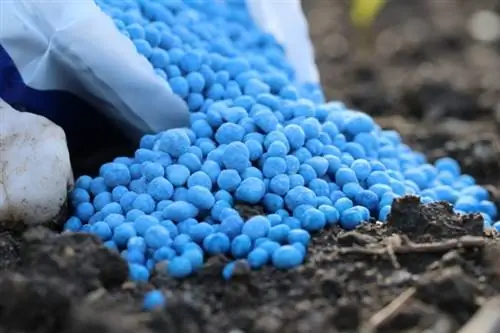
Frequently asked questions
Can rhubarb be fertilized with coffee grounds?
Yes, but only in smaller quantities, because coffee grounds easily acidify the soil. It's best to add it to the compost heap and then administer it via the compost.
Can rhubarb grow permanently in the same location?
In order to achieve consistently good yields, you should change location every eight to ten years.
How does a possible nutrient deficiency manifest itself?
Nutrient deficiency usually manifests itself in yellowing leaves. From August onwards, this can also be an indication that the perennial is moving in or going into hibernation.

